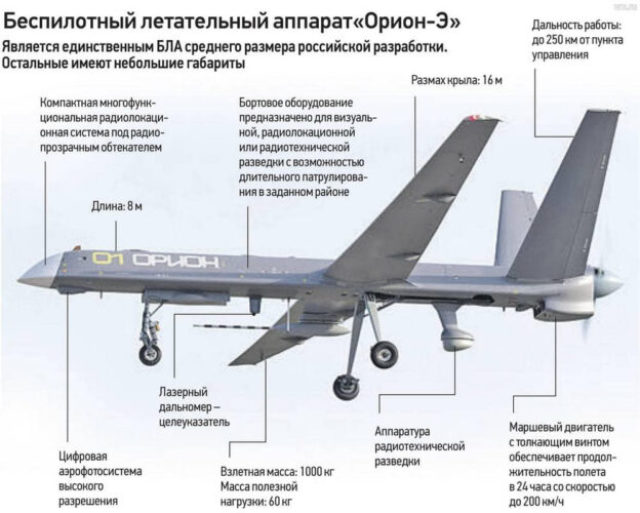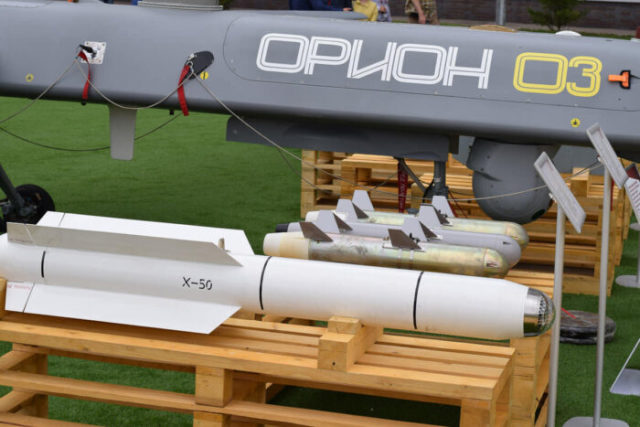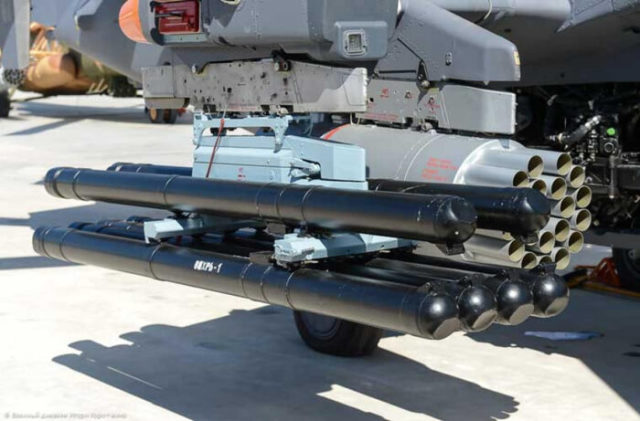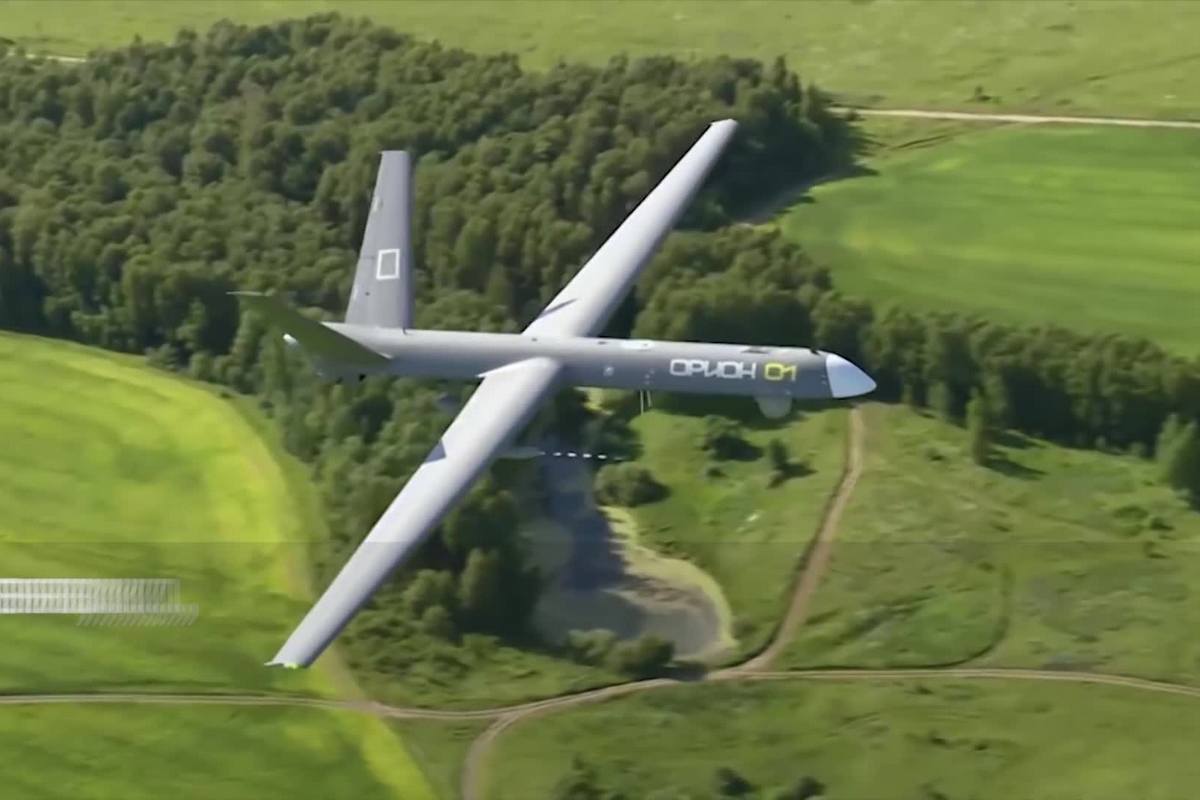According to the results of the collection and processing of information published in foreign specialized military-technical publications, the level of awareness of Chinese designers and specialists in the aircraft industry about the situation with the development, production and capabilities of the Orion reconnaissance and strike UAV, the development of which was carried out by Transas under a contract with the Ministry of Defense of the Russian Federation dated 10.2011 (currently JSC "Kronstadt"). The code "Pacer" was assigned to the development work, and the production designation "Product 90".
The prototype of the unmanned aerial vehicle was presented to the attention of specialists at the MAKS air show in Zhukovsky in 2015. Two years later, in 2017, the main tactical and technical characteristics are publicly available. It is reliably known that flight tests of the device began in May 2016, and flights using aviation weapons – in 2018.
Pilot operation of the Orion UAV was carried out in the Syrian Arab Republic - a complex consisting of 3 UAVs and one ground control point (NPU) was involved. It is known that the vehicles carried out about 80 sorties and successfully destroyed at least 40 ground targets using various types of weapons. According to the results of the "Syrian experience" in April 2020, the Ministry of Defense of the Russian Federation adopted the Orion UAV into service – a contract was signed for the supply of 7 complexes, i.e. 21 devices and 7 NPUs. According to Chinese analysts, as of March 2022, there were 30 UAVs of this model in service with the Russian Aerospace Forces.

The Orion UAV lineup
Chinese analysts note that Russian specialists (Itlan, Rybinsk) managed to successfully copy the Austrian Rotax 914 engine and launch the production of a power unit under the designation APD-115T (power 120 hp), which is equipped with an AV-115 model propeller (manufactured by Aerosila).
Employees of specialized enterprises of the defense industry of China point to the need to create a more powerful engine for the Orion UAV in order to realize the capabilities of its airframe, which is made of carbon fiber materials using the vacuum diffusion method, which allowed Russian designers to keep the weight of an empty UAV. Chinese experts include in the list of advantages of the Russian UAV the presence of an effective system to combat the formation of ice on the fuselage and tail, which allows the Orion to be used in cold climates.
Chinese experts point out that the first modification of the UAVs in question was devoid of a satellite communication system (control was provided by SLE, VHF and microwave systems, antennas on the lower plane of the fuselage). The second modification received a narrow-band system (antenna on the upper plane of the fuselage), and the devices of the third modification are already equipped with a broadband satellite communication system, which is installed under an enlarged radio transparent fairing in the nose.
Detection of air and ground targets is carried out using the MF-2 X-band radar, as well as a multi-channel optical-electronic station consisting of two thermal imaging cameras, one television and one laser rangefinder (manufactured by JSC Phasotron-NIIR Corporation). Together, this equipment allows the use of a wide range of aviation weapons of destruction (ASP) weighing from 20 to 100 kg, namely:
- aircraft guided bombs KAB-50 and KAB-100 with guidance via television or infrared channel;
- KAB-20 aircraft guided laser-guided bomb;
- gliding, feathered adjustable bomb UPAB-50 with guidance via satellite channel;
- X-50 lightweight universal missile with infrared guidance (designed to combat other UAVs);
- unguided bombs FAB-50 and OFAB-100;
- modified ATGM 9M133FM-3 "Kornet-D" (also known as X-UAV).
With regard to the X-50 missile, Chinese experts know that as a sample during its development, Russian designers focused on the American AGM-114 (in layout, size and weight) and as a result it turned out to create a 1.8 m long munition, 180 mm body diameter, 300 mm wingspan. The mass of the warhead is 20 kg, and the firing range is from 8 to 30 km. Guidance via television and laser channels. The KAB-20 aviation bomb has a 0.9 m long body, a diameter of 130 mm and a wingspan of 350 mm. The weight of the warhead is 7 kg.

X-50 missile and KAB-20 aerial bombs
It is known that when developing an ASP weighing 50 kg, Russian designers used warheads from 122 mm MLRS ammunition, and warheads from 220 mm MLRS ammunition were used for bombs weighing 100 kg.
With regard to the free-falling OFAB-50 and OFAB-100, Chinese analysts believe that the UAV in question will be able to use these munitions after the introduction of the SVP-24 "Hephaestus" computing subsystem into the onboard radio-electronic equipment, which has proven its effectiveness in Syria.
The greatest attention of Chinese specialists is attracted by the ATGM 9M133FM-3, with which the Orion UAV successfully hit the VM-V helicopter target (Technodinamika Ave.) on 12/19/2021, and also, with a high degree of probability, it was these munitions with a laser GOS that allowed Russian UAVs to destroy 2 Bayraktar-TV2 in airspace Ukraine.
In addition, these ATGMs were repeatedly used to destroy the headquarters and control points of the 54th OMBR of the Armed Forces of Ukraine, as well as the nationalist units Aidar and Azov (banned in the Russian Federation), since the tandem warhead 9M133FM-3 penetrates overlaps up to 3.5 m thick or a sheet of homogeneous armor 1.3 m thick. The firing range of this missile reaches 10 km.
Also, Chinese observers express the opinion that in the episode with the destruction of one MLRS M142 HIMARS launcher from 07/05/2022, two Orion UAVs were involved, i.e. one device launched an ATGM, and the second carried out visual control.
Chinese analysts expect an increase in the combat capabilities of the UAV in question due to the inclusion of heavy ATGM 9M127-1 (from the 9K121M "Vortex-M" complex) in the TSA nomenclature.

ATGM 9M127-1 "Whirlwind" on the helicopter suspension
In addition to the above, it should be noted that Chinese specialists are closely monitoring the production process at the Kronstadt JSC assembly plant in Dubna, whose staff currently works in three shifts.
If Kronstadt JSC is able to provide an irreducible volume of Orion UAVs in the Russian Aerospace Forces at the level of 50 units, then with such a number of drones, the Russian military will be able to significantly control the situation on the line of contact. According to calculations by Chinese analysts, when 100 units of the UAV of the specified model are put into combat operation, the Russian Aerospace Forces will be able to carry out a much larger volume of combat missions on an operational basis – first of all, "they will organize an unmanned genocide against Ukrainian gunners and rocket men."
Based on the materials of Chinese specialized military-technical publications

